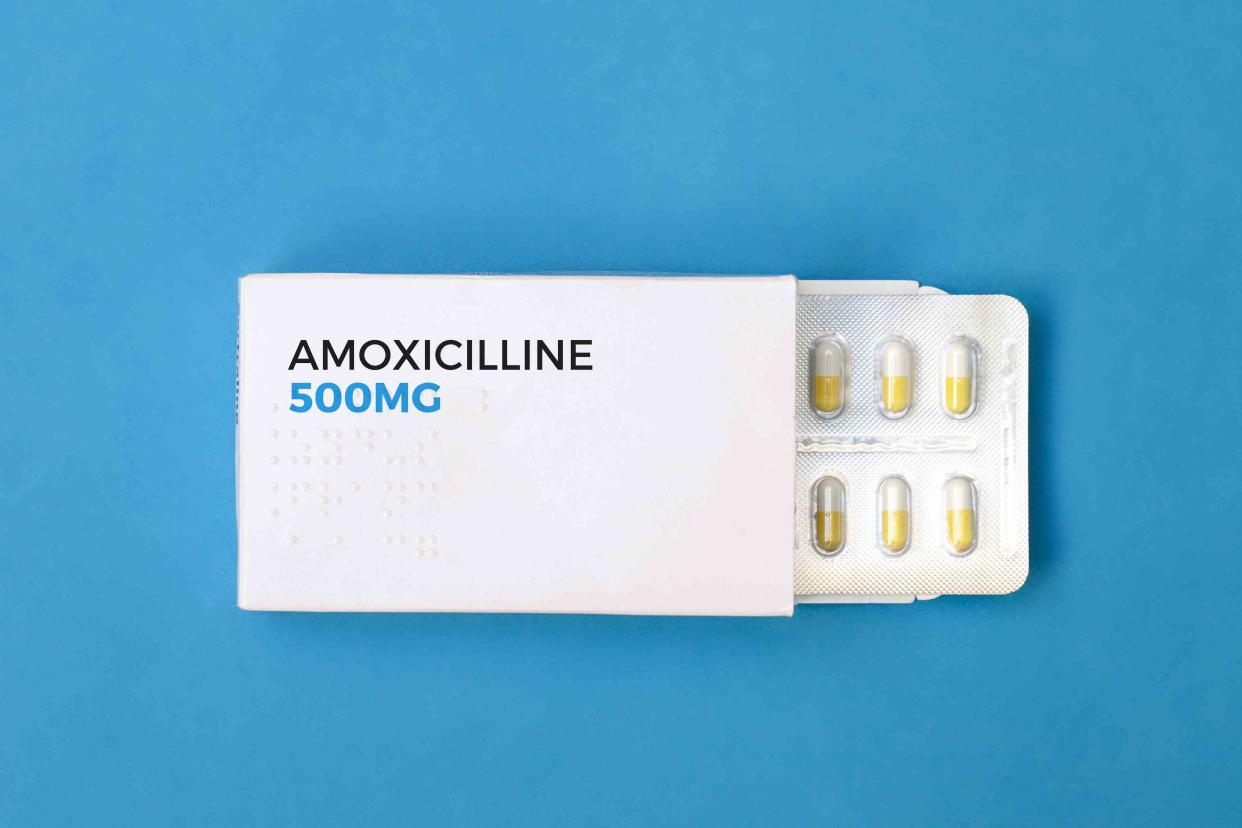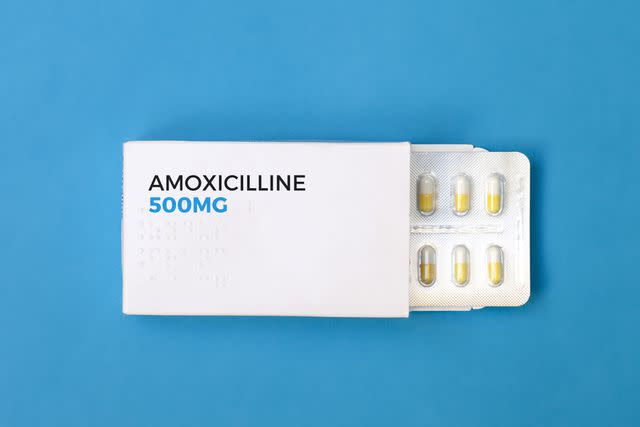Taking Amoxicillin for a Sinus Infection: What to Expect

Getty Images / laurence soulez
Medically reviewed by Alex Yampolsky, PharmD
Amoxil (amoxicillin) is an antibiotic used to help kill bacteria that can cause infections in your body, such as a sinus infection.
Sinus infections can be viral and self-limiting, which means your body can usually fight the infection off on its own and does not require antibiotics. Taking antibiotics for a viral infection won't help your symptoms go away faster and might increase the risk of your body developing antibiotic resistance.
However, in some cases, a sinus infection can start as viral and progress to a secondary bacterial infection. If the infection is bacterial, an antibiotic like amoxicillin might be necessary to clear it.
This article will cover the use of amoxicillin for bacterial sinus infections, including how it works and what to expect when taking it.

Getty Images / laurence soulez
How Does Amoxicillin Work for a Sinus Infection?
Amoxicillin is an antibiotic made from penicillin, a type of mold that scientists discovered would fight against and kill certain types of bacteria. Amoxicillin works by stopping a bacterial cell from building a cell wall, which can then cause it to die.
In sinus infections, symptoms can include but are not limited to:
Facial pain or fullness
Congestion (stuffy nose)
Thick mucus that is colored
Losing the ability to smell temporarily
Fever
Amoxicillin can help kill bacteria that are causing the infection in sinusitis confirmed to be caused by bacteria. These bacteria can include:
Haemophilus influenzae
Staphylococcus aureus
Streptococcus pneumoniae
Bacterial vs. Viral Sinus Infections
Antibiotics are not necessary for viral sinus infections. Typically, a viral sinus infection will resolve within 10 days.
However, your healthcare provider may prescribe an antibiotic like amoxicillin if they suspect your sinus infection is bacterial. This may be the case if your symptoms have not improved on their own after 10 days, if you develop a high fever, if you develop more severe symptoms after three or four days, or if you begin to feel better and then your symptoms worsen.
How to Take Amoxicillin for a Sinus Infection
The dose of amoxicillin you get will depend on your age and kidney health:
For people with normal kidney function and who are over 3 months old:
Moderate infections: 250 milligrams (mg) every eight hours or 500 mg every 12 hours by mouth
Severe infections: 500 mg every eight hours or 875 mg every 12 hours by mouth
For children younger than 3 months old, the dosing is calculated by using the weight of the child and will be determined by your primary healthcare provider.
If your child weighs more than 88 pounds, the adult dosing recommendations may be used by your primary healthcare provider for your child.
The dosing for people with poor kidney function may be different, as follows:
Severe kidney impairment: The dose may range from 250 to 500 mg every 12 to 24 hours, depending on the severity of your kidney impairment and the severity of your infection.
People on hemodialysis: A dose of 250 to 500 mg every 24 hours may be given, with an additional dose possibly being given before or after your dialysis session.
Antibiotics can affect the natural bacteria that are found in your stomach. This can cause stomach upset, nausea, or diarrhea. If you have any stomach problems while taking amoxicillin, taking it with food can sometimes help reduce these symptoms.
It is very important to take amoxicillin as it was prescribed. Even though you may feel better after a few days, it is important to complete the treatment plan set by your healthcare provider.
How Long Will Amoxicillin Take to Work?
Amoxicillin concentrations usually will be at their highest around one hour after you take your dose, but it may take a few days to start feeling better.
It is important always to take amoxicillin for however long your healthcare provider prescribed it. Not taking your medication for as long as prescribed can lead to your body developing resistance to amoxicillin, which can make it harder to treat infections in the future.
Related: How Quickly Does Amoxicillin Work?
What Happens If I Miss a Dose?
If you forget to take a dose of your amoxicillin, take it as soon as you remember. However, if it is closer to your next dose, it is best to wait for the next dose and skip the missed one. Do not take two doses of amoxicillin at the same time.
Missing one dose of amoxicillin should not affect your treatment outcome, but it's always a good idea to follow up with your healthcare provider if you feel symptoms worsening.
What Side Effects Should I Expect?
As with other antibiotics, side effects are possible with amoxicillin. That being said, you might not experience any side effects at all with it.
Common side effects that are seen with amoxicillin include but are not limited to:
Nausea
Rash
Diarrhea
Vomiting
More serious side effects that can be seen with amoxicillin and warrant immediate medical attention may include:
Anaphylaxis (inability to breathe due to swelling of the throat, face, or body)
Clostridium difficile–associated diarrhea: Clostridium difficile (C. diff) is a bacteria that can infect the gut, especially when antibiotics are used for longer periods. Let your healthcare provider know if you develop severe diarrhea while on amoxicillin, as a test for C. diff may be needed.
Precautions
There are a few key precautions to be aware of before starting treatment with amoxicillin:
Penicillin allergy: Tell your healthcare provider if you've ever had a hypersensitivity reaction (e.g., rash, swelling of the throat) to a penicillin-type antibiotic or cephalosporin antibiotic.
Gout medications: Tell your provider about medications you are taking for gout, including Zyloprim (allopurinol) or Probalan (probenecid). These drugs can negatively interact with amoxicillin, causing an increase in the amount of the antibiotic in your blood.
Oral contraceptives (birth control pills): Amoxicillin may reduce the effectiveness of birth control pills. If you are trying to prevent pregnancy, consider using an additional form of contraception while taking amoxicillin.
Blood thinners: Taking amoxicillin while also taking a blood thinner can increase your risk of bleeding. It is a good idea to consult your healthcare provider about using both medications at the same time.
Pregnancy or breastfeeding: Before starting amoxicillin, talk to your healthcare provider if you are pregnant or breastfeeding. Amoxicillin can pass through breast milk and affect the nursing infant.
Alternative Treatments for a Sinus Infection
Other antibiotics that may be used instead of amoxicillin include:
Augmentin (amoxicillin/clavulanate): Augmentin is another version of amoxicillin that contains the additional medication clavulanate. Combining both medications is often used when bacteria develop resistance (the bacteria will no longer die from just amoxicillin alone).
Doxycycline: Doxycycline is a type of antibiotic that belongs to the class called tetracyclines. Doxycycline is often used as an alternative to amoxicillin or Augmentin if you have a penicillin allergy.
Cefpodoxime: Cefpodoxime is a type of antibiotic that belongs to a class called cephalosporins. These antibiotics are often used as an alternative to amoxicillin. They can also help treat the bacteria that cause sinusitis.
Clindamycin: Clindamycin is a type of antibiotic that belongs to the class called lincosamides. Clindamycin is often used with other antibiotics to help increase their bacteria-fighting power.
Summary
Amoxicillin can be used to treat bacterial sinus infections, otherwise known as sinusitis. Bacterial sinusitis can cause uncomfortable or painful pressure around your sinuses, with congestion, along with the possibility of fever and a temporary loss of smell.
Remember to take amoxicillin exactly as prescribed by your primary care provider, making sure to finish all the doses in your regimen. Side effects of taking amoxicillin can include nausea, upset stomach, diarrhea, or vomiting. Let your healthcare provider know if you develop severe diarrhea during your treatment.
Frequently Asked Questions
How does amoxicillin compare with doxycycline for a sinus infection?
Both amoxicillin and doxycycline can be used for the treatment of sinus infections. Doxycycline is often used if you have an allergy to the penicillin-type of antibiotics (which includes amoxicillin) or if you have an allergy to cephalosporins (amoxicillin and cephalosporins have a similar chemical structure, which can cause someone to be allergic to both types of antibiotics).
How long will I have to take amoxicillin?
Your healthcare provider should give you a timeline for how long you should take your medication, which can range from five to 14 days, depending on the severity of your infection.
It is always very important to complete the entire course of antibiotics prescribed, as not taking them as directed can lead to your infection returning or your body developing an antibiotic resistance to amoxicillin in the future.
The author would like to recognize and thank Jon Candelaria for contributing to this article.

